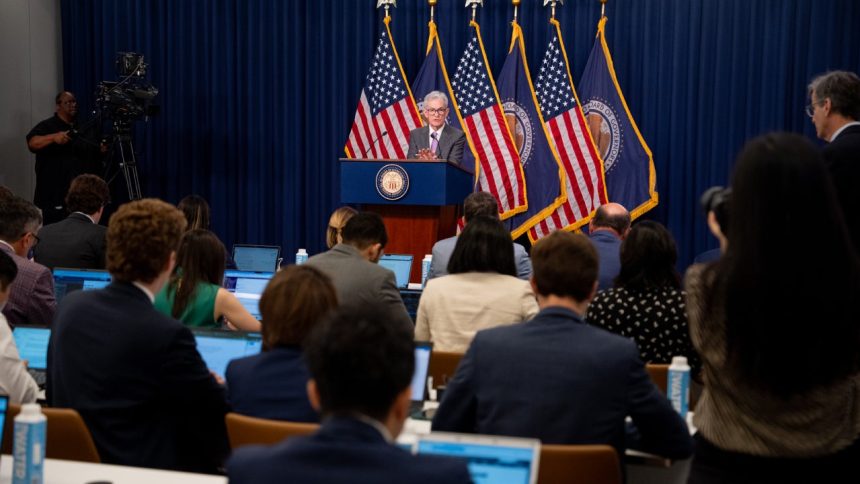Can the U.S. economy continue chugging along with interest rates at the highest level in two decades? It’s a question rattling throughout financial markets following July’s weak jobs report and the subsequent global sell-off in equities.
After its meeting last week, the Federal Reserve kept interest rates at 5.25 percent to 5.5 percent. July’s jobs report was released shortly after the meeting, showing slower growth than expected and an uptick in the unemployment rate to 4.3 percent. That’s the highest unemployment rate since October 2021, though it’s still a historically low figure. What followed was a global frenzy in the stock markets. As of Monday, Japan’s Nikkei dropped more than 12 percent, while U.S. stock markets fell by more than 2.5 percent.
Many financial experts and investors anticipate the Fed will cut interest rates in its September meeting. However, with that meeting seven weeks away, some economists are now speculating that the Fed could announce an emergency rate cut before then due to growing recession fears. Bankrate’s Second-Quarter Economic Indicator Survey found there’s a 32 percent chance the economy will be in a recession by this time next year.
Emergency rate cuts are rare and typically occur during extreme emergencies. In the last two decades, the Fed approved emergency rate cuts only seven times: three in 2001 after the Sept. 11 terrorist attacks and during the tech stock bubble burst; two during the Great Recession; and two during the COVID-19 pandemic.
Here’s what the experts are saying about the potential for an eighth emergency rate cut.
Will the Fed make an emergency rate cut? Economists and financial experts have mixed reactions
With recession fears on the rise, many economists and financial experts are divided on whether the Fed will implement an emergency rate cut before its next meeting in September.
For most of the past two years, the Fed has hiked interest rates to control the pace of inflation that has bedeviled consumers since the start of the COVID-19 pandemic. Those rate hikes have driven inflation downward, from 9.1 percent in June 2022 to 3 percent in June 2024. The central bank is now wrestling with the question of when to reverse course. If it keeps rates elevated for too long, it could push the economy into recession.
Greg McBride, CFA and Bankrate’s chief financial analyst, says a weaker-than-expected jobs report and a stock market sell-off aren’t enough to justify the Fed cutting rates between meetings.
“It will take more than 114,000 new jobs and a normal, and overdue, market correction to do it,” McBride says.
Mark Hamrick, senior economic analyst at Bankrate, says the U.S. economy is “not even close to the sort of crisis developments that would motivate the Fed to cut rates between meetings.”
In order for the Fed to make a move like that, Hamrick says that markets would need to seize up to the point where businesses and consumers would have extremely limited access to cash and borrowing money, similar to what was seen early in the COVID-19 pandemic and during the 2007–2008 financial crisis.
“It can be argued that the current level of their benchmark rate is overly restrictive and needs to come down,” Hamrick says. “That’s why expectations are high that a September rate cut is likely.”
However, two prominent economists say that stock market turmoil could be enough reason for an emergency Fed rate cut. Paul Krugman, a Nobel laureate in economics and a New York Times Opinion columnist, wrote on X that he wasn’t anticipating an inter-meeting rate cut from the Fed because it would incite more panic, but with the already-high level of panic among investors, he says there may be a “real case for an emergency cut soon.”
“So, even though I’ve been arguing for rate cuts — 50 in September for sure — I wasn’t calling for an inter-meeting cut, because that might signal panic,” Krugman wrote on X. “But since we may be seeing a panic anyway, that argument loses its force.”
Jeremy Siegel, an economist at the Wharton School of the University of Pennsylvania, voiced concerns over the Fed’s recent decision to keep interest rates steady and called for a 75-basis-point emergency cut in the Fed funds rate during an interview with CNBC’s “Squawk Box.” Siegel also predicts another 75-basis-point cut at the Fed’s September meeting.
“We’ve gone 90 percent toward the target on the inflation rate,” he said in the interview. “We’ve overshot the target on unemployment [4.2 percent]. Those are the two targets explicitly mentioned by the Federal Reserve. How much have we moved the Fed funds rate? Zero.”
Sarah Hunt, chief market strategist at Alpine Saxon Woods, said in a Bloomberg TV interview that if the Fed did an emergency rate cut, it could alarm consumers that the economy is in worse shape than expected.
“The concern of the Fed doing an emergency cut or stepping in too hard is now going to worry people even further, in a way that isn’t necessarily going to be helpful,” Hunt said in the interview. “These markets need to stabilize.”
In a CNBC “Squawk Box” interview, Chicago Federal Reserve President Austan Goolsbee wouldn’t say whether the central bank would make an emergency rate cut, but he did acknowledge that the Fed has been in a “restrictive posture” regarding its monetary policy. He emphasized that the Fed will step in if the economy starts to deteriorate.
“You only want to be that restrictive if there’s fear of overheating. The data to me does not look like overheating,” Goolsbee said in the interview. “It’s the markets’ job to react, and the Fed’s job to act.”
3 reasons why there likely won’t be an emergency rate cut by the Fed
A few economists and financial experts anticipate an emergency Fed rate cut, but many don’t. Here are three reasons why the Fed likely wouldn’t step in before its next meeting in September.
- It would further worry Americans. An emergency rate cut may create more fear among Americans and cement worries that the U.S. is headed toward a recession. The Fed strives to maximize employment, stabilize prices and maintain financial stability, so an inter-meeting rate cut could have the opposite effect that the Fed wants.
- Some stock market volatility isn’t enough to prompt an emergency Fed rate cut. Markets react faster and are more volatile than monetary policy. Given the limited economic data, many experts believe the stock market’s volatility is an overreaction. However, some experts argue that the panic is already enough for the Fed to take action and implement an emergency rate cut.
- The economy isn’t showing enough signs of distress. While there has recently been some weaker economic data, it isn’t enough to sound alarms. The economy added fewer jobs than expected in July and unemployment crept up to 4.3 percent, but that’s still a historically low figure for unemployment. Inflation fell to 3 percent in June, the lowest it’s been since early 2021, according to the latest CPI report. Real gross domestic product (GDP), a key indicator of economic growth, rose 2.8 percent in the second quarter of 2024, according to Bureau of Economic Analysis data.
Read the full article here
















